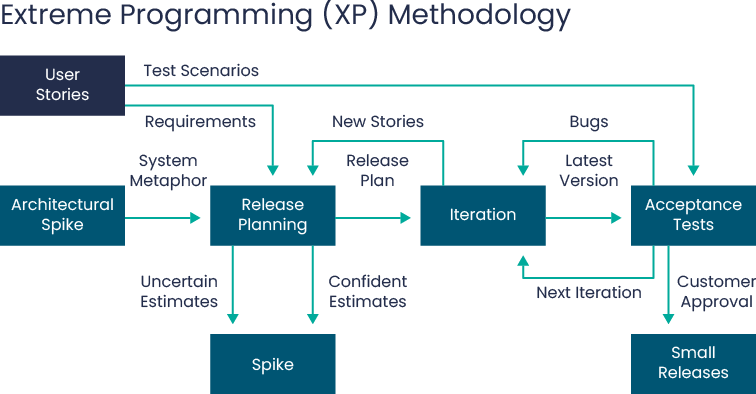In the ever-evolving landscape of business, traditional Human Resources (HR) practices often struggle to keep pace with the dynamic needs of the workforce. This article delves into the application of Xtreme Programming (XP) principles in HR, providing real-world scenarios where XP can bring about transformative change. By examining examples from industry leaders like Google, Spotify, Zappos, Amazon, and Salesforce, we’ll unravel the step-by-step implementation process to showcase how XP can be the catalyst for a paradigm shift in HR practices.
Extreme Programming (XP) is an agile software development methodology that was created by Kent Beck in the late 1990s. XP is designed to improve software quality and responsiveness to changing customer requirements through frequent releases in short development cycles. While XP was initially developed for software development, its principles have been adapted and applied in various domains beyond programming, including project management, HR, and business processes.
Here are the key principles and practices associated with Extreme Programming:

- Customer Involvement:
- XP emphasizes continuous customer involvement throughout the development process. Customers, or stakeholders, work closely with the development team to provide feedback, prioritize features, and make decisions about the project direction.
- Frequent Releases:
- XP promotes frequent and small releases of working software. This allows for rapid adaptation to changing requirements and provides stakeholders with tangible results at the end of short development cycles.
- Iterative Development:
- XP follows an iterative development approach. The project is divided into small, manageable units, and each iteration produces a working piece of software. The team revisits and refines the product based on feedback after each iteration.
- Continuous Integration:
- Continuous Integration (CI) is a fundamental practice in XP. Developers integrate their code frequently, ensuring that the latest changes from all team members are integrated into a shared codebase. Automated tests are run to detect and fix integration issues early.
- Test-Driven Development (TDD):
- Test-Driven Development is a core practice in XP. Before writing the actual code, developers write automated tests to define the expected behavior of the software. This helps ensure that the code meets the requirements and can be easily refactored without introducing errors.
- Pair Programming:
- XP encourages pair programming, where two developers work together at one computer. One writes the code, and the other reviews each line as it is written. This collaborative approach improves code quality, spreads knowledge among team members, and reduces the likelihood of errors.
- Simple Design:
- XP advocates for simplicity in design. The focus is on creating the simplest solution that meets the current requirements. If additional features are needed, the design can be refactored accordingly.
- Refactoring:
- Refactoring involves restructuring and cleaning up the code without changing its external behavior. XP teams regularly refactor code to improve its maintainability, readability, and efficiency.
- Collective Code Ownership:
- In XP, all team members have collective ownership of the codebase. This means that any team member can modify or improve any part of the code. This promotes collaboration, knowledge sharing, and a sense of shared responsibility.
- On-Site Customer:
- Ideally, XP teams have an on-site customer who is readily available to provide clarification on requirements, answer questions, and make decisions. This ensures that the development team has direct access to the customer’s perspective.
Extreme Programming’s strength lies in its adaptability to changing requirements, customer involvement, and emphasis on delivering high-quality software through disciplined development practices. While it originated in the software development domain, the principles of XP have been successfully applied in various industries and organizational functions to foster agility and responsiveness.
Application in HR:
Adapting Extreme Programming (XP) principles to Human Resources (HR) can bring about a paradigm shift in the way HR functions operate. By leveraging XP practices, HR departments can enhance agility, responsiveness, and collaboration, ultimately leading to more effective talent management and employee engagement. Here’s how XP principles can be applied in HR:
- Continuous Feedback and Improvement:
- Application in HR: Establish a culture of continuous feedback within the HR department. Encourage regular one-on-one meetings between HR professionals and employees, fostering open communication for feedback on HR processes and policies. Implement iterative feedback loops through surveys and sessions to identify areas for improvement.
- Frequent Releases:
- Application in HR: Instead of annual performance reviews, consider more frequent and smaller feedback sessions. Regularly release updates to HR policies, benefits, or training programs to adapt to the changing needs of the workforce in real-time.
- Iterative Development:
- Application in HR: Break down HR projects into smaller, manageable units. Adopt an iterative approach to HR processes, such as recruitment, employee onboarding, and training. Regularly assess and refine these processes based on feedback and changing organizational needs.
- Continuous Integration:
- Application in HR: Embrace continuous integration by ensuring that HR systems are seamlessly integrated with other organizational systems. This can include integrating HR data with performance management, payroll, and other business systems to streamline processes and improve data accuracy.
- Test-Driven Development (TDD):
- Application in HR: Implement Test-Driven Development in HR policies and programs. Before rolling out new HR initiatives, conduct small-scale pilot programs to test their effectiveness. Use key performance indicators (KPIs) and employee feedback to drive decision-making and refine HR practices.
- Pair Programming:
- Application in HR: Foster collaboration and knowledge-sharing through pair programming in HR projects. For example, when designing and implementing new employee development programs or diversity and inclusion initiatives, have HR professionals work together to ensure diverse perspectives and effective problem-solving.
- Simple Design:
- Application in HR: Prioritize simplicity in HR processes and policies. Aim for straightforward and easily understandable HR documentation, such as employee handbooks and benefit guides. This can enhance employee understanding and compliance.
- Refactoring:
- Application in HR: Regularly review and update HR processes and policies to keep them aligned with legal requirements and industry best practices. Refactor employee handbooks, training materials, and performance appraisal systems to ensure they remain effective and up-to-date.
- Collective Code Ownership:
- Application in HR: Promote a sense of collective ownership among HR professionals. Encourage cross-functional collaboration within the HR department, allowing team members to contribute to various HR functions. This shared responsibility enhances collaboration and knowledge transfer.
- On-Site Customer:
- Application in HR: Aim for direct and continuous interaction between HR professionals and employees. Having an on-site HR representative or utilizing HR technology for real-time communication can ensure that HR is attuned to the needs and concerns of employees, fostering a more responsive HR function.
By embracing Extreme Programming principles in HR, organizations can create an HR function that is agile, responsive, and closely aligned with the evolving needs of the workforce. The iterative and collaborative nature of XP can contribute to more effective talent management, improved employee engagement, and a positive organizational culture.
Company Examples:
Scenario 1: Continuous Feedback and Improvement at Google
Step-by-Step Implementation:
- Establish a Feedback Culture: Google fosters a culture of continuous feedback by encouraging regular one-on-one meetings between employees and managers. This open communication channel allows for the exchange of ideas, concerns, and suggestions related to HR policies and practices.
- Implement Iterative Feedback Loops: Google conducts regular surveys and feedback sessions to gather input from employees on HR processes. This iterative approach enables the HR team to identify areas for improvement and make adjustments in real-time.
- Adaptation and Flexibility: Based on the collected feedback, Google adapts HR policies swiftly, demonstrating flexibility in responding to the evolving needs of its workforce. This adaptability ensures that HR practices remain aligned with employee expectations.
Scenario 2: Pair Programming for Talent Development at Spotify
Step-by-Step Implementation:
- Identify Skill Gaps and Development Needs: Spotify assesses the skills and development needs of its workforce to identify areas where pair programming can be most effective. This involves conducting regular skills assessments and performance reviews.
- Implement Pair Programming Initiatives: Spotify introduces pair programming initiatives, where employees collaborate on projects, share knowledge, and learn from each other. This approach promotes a culture of mentorship and continuous learning within the organization.
- Measure and Refine: Regularly measure the effectiveness of pair programming initiatives through performance metrics and employee feedback. Refine the program based on these assessments to ensure ongoing improvement in talent development strategies.
Scenario 3: Onsite Customer (Employee) Collaboration at Zappos
Step-by-Step Implementation:
- Establish Direct Channels of Communication:Zappos facilitates direct communication between HR and employees through open forums, suggestion boxes, and regular town hall meetings. This establishes a transparent and accessible platform for employees to voice their opinions and concerns.
- Collaborative Policy Design:Zappos involves employees in the design and improvement of HR policies. This collaborative approach ensures that HR practices are not only compliant with regulations but are also tailored to meet the specific needs and expectations of the workforce.
- Continuous Feedback Mechanism:Maintain an ongoing feedback mechanism to gather insights from employees about the effectiveness of HR policies. Adjustments and improvements are made based on this feedback to enhance employee satisfaction and engagement.
Scenario 4: Test-Driven Development for HR Processes at Amazon
Step-by-Step Implementation:
- Identify Key HR Initiatives:Amazon selects key HR initiatives, such as performance management systems or employee wellness programs, for test-driven development. These initiatives are chosen based on their potential impact on employee satisfaction and organizational performance.
- Conduct Small-Scale Pilots:Before full-scale implementation, Amazon conducts small-scale pilot programs to test the effectiveness of the chosen HR initiatives. This involves selecting a subset of employees or departments to participate in the pilot.
- Evaluate and Refine:Evaluate the results of the pilot programs, considering both quantitative data and qualitative feedback from participants. Refine the HR initiatives based on these evaluations before implementing them organization-wide.
Scenario 5: Collective Code Ownership and Cross-Functional Teams at Salesforce
Step-by-Step Implementation:
- Establish Cross-Functional HR Teams:Salesforce structures HR teams to be cross-functional, bringing together professionals with diverse expertise in talent management, recruitment, employee engagement, and other HR functions.
- Foster Collective Ownership:Promote a culture of collective ownership by encouraging collaboration and knowledge-sharing among HR teams. This ensures that HR policies and practices are developed and implemented with a holistic understanding of the organization’s goals.
- Regular Collaborative Sessions:Schedule regular collaborative sessions where HR professionals from different functions come together to discuss ongoing projects, share insights, and align strategies. This collaborative approach ensures a cohesive and integrated HR function.
Conclusion:
The step-by-step implementation processes outlined using real-world examples from Google, Spotify, Zappos, Amazon, and Salesforce serve as a guide for organizations looking to transform their HR practices. By examining these scenarios, it becomes evident that Xtreme Programming principles can be customized to address the unique needs and culture of each organization, fostering a more responsive, adaptive, and employee-centric HR function. Embracing XP principles is not just a trend but a strategic move towards creating HR practices that actively contribute to the overall success and adaptability of the organization in an ever-evolving business landscape.











